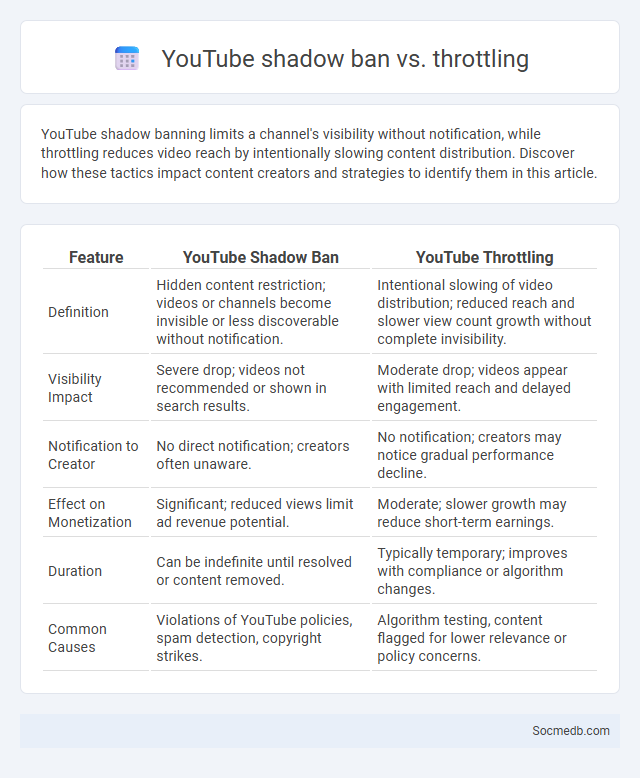
Photo illustration: YouTube shadow ban vs throttling
YouTube shadow banning limits a channel's visibility without notification, while throttling reduces video reach by intentionally slowing content distribution. Discover how these tactics impact content creators and strategies to identify them in this article.
Table of Comparison
| Feature | YouTube Shadow Ban | YouTube Throttling |
|---|---|---|
| Definition | Hidden content restriction; videos or channels become invisible or less discoverable without notification. | Intentional slowing of video distribution; reduced reach and slower view count growth without complete invisibility. |
| Visibility Impact | Severe drop; videos not recommended or shown in search results. | Moderate drop; videos appear with limited reach and delayed engagement. |
| Notification to Creator | No direct notification; creators often unaware. | No notification; creators may notice gradual performance decline. |
| Effect on Monetization | Significant; reduced views limit ad revenue potential. | Moderate; slower growth may reduce short-term earnings. |
| Duration | Can be indefinite until resolved or content removed. | Typically temporary; improves with compliance or algorithm changes. |
| Common Causes | Violations of YouTube policies, spam detection, copyright strikes. | Algorithm testing, content flagged for lower relevance or policy concerns. |
Understanding YouTube Shadow Ban: Definition and Signs
YouTube shadow ban refers to the platform's covert restriction of your content, making it less visible without your knowledge. Signs of a shadow ban include a significant drop in video views, lack of engagement from new viewers, and absence from search results or recommendations. Understanding these indicators helps you take timely action to restore your channel's visibility and growth.
What is Throttling on YouTube?
Throttling on YouTube refers to the intentional slowing down of video streaming by internet service providers (ISPs) or YouTube itself to manage bandwidth and reduce network congestion. This practice can cause buffering, lower video quality, and interruptions in playback, impacting Your overall viewing experience. Understanding throttling helps You recognize when your connection speed is being limited, allowing for better troubleshooting and optimization of streaming settings.
Shadow Banning Explained: Beyond YouTube
Shadow banning is a covert practice used by social media platforms to limit the visibility of a user's content without their knowledge, affecting platforms beyond YouTube such as Instagram, Twitter, and TikTok. This technique reduces engagement by making your posts less discoverable through hashtags, search results, or follower feeds, thereby quietly suppressing influence or reach. Understanding shadow banning helps you recognize diminished interaction patterns and adjust content strategies to maintain your online presence.
Key Differences: Shadow Ban vs Throttling vs Shadow Banning
Shadow ban hides Your content from public view without notification, limiting reach silently. Throttling reduces content distribution speed or frequency, deliberately slowing audience exposure. Shadow banning encompasses both practices, restricting visibility and engagement to control platform integrity.
Causes of YouTube Shadow Bans
YouTube shadow bans often result from algorithmic detection of content that violates community guidelines, including misinformation, hate speech, or spam-like behavior. Repeated copyright infringements or misleading metadata such as tags and titles can trigger reduced video visibility. User reports and engagement anomalies also contribute to content being throttled without explicit notification.
How Throttling Impacts YouTube Visibility
Throttling on YouTube limits the bandwidth available to content creators, reducing video loading speeds and stream quality for viewers, which directly impacts channel visibility and engagement metrics. Algorithms prioritize videos with higher watch time and user interaction, so throttled videos experience drops in ranking and search discoverability. Persistent throttling can diminish ad revenue and subscriber growth by lowering overall audience retention and satisfaction.
Common Reasons for Shadow Banning on Social Platforms
Shadow banning on social media often occurs due to violations of community guidelines, such as posting inappropriate content or engaging in spam-like behavior. Automated algorithms detect risky activities like excessive hashtag use, repeated comments, or aggressive following patterns that trigger restrictions. Understanding these common reasons helps you avoid shadow banning and maintain visibility on your preferred platforms.
Detecting If You’ve Been Shadow Banned or Throttled
Detecting if you've been shadow banned or throttled on social media involves monitoring sudden drops in engagement metrics such as likes, comments, and shares without a corresponding change in content quality. Tools like analytic dashboards and third-party apps can help identify restricted visibility by comparing your post reach over time. Understanding these indicators allows your account to adapt strategies to restore normal audience interaction and growth.
Solutions and Prevention: Avoiding YouTube Penalties
Implement clear content guidelines and use automated tools to monitor uploads for copyright compliance, avoiding strikes and demonetization on YouTube. Regularly educate creators on YouTube's community standards and copyright policies to prevent violations. Employ fair use assessments and obtain necessary licenses to minimize the risk of penalties and sustain channel growth.
YouTube’s Official Stance on Shadow Banning and Throttling
YouTube officially denies the practice of shadow banning but acknowledges algorithmic adjustments intended to reduce content violating its guidelines from appearing prominently. The platform emphasizes transparency through tools like the YouTube Studio dashboard, enabling creators to monitor video performance and community guideline strikes. This approach aims to balance user experience with policy enforcement, avoiding punitive invisibility while managing problematic content visibility.
 socmedb.com
socmedb.com